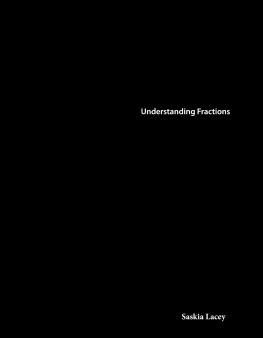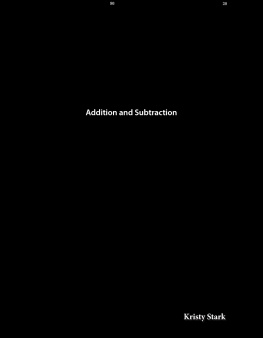Saskia Lacey - The History of Victorian Innovations: Equivalent Fractions
Here you can read online Saskia Lacey - The History of Victorian Innovations: Equivalent Fractions full text of the book (entire story) in english for free. Download pdf and epub, get meaning, cover and reviews about this ebook. year: 2017, publisher: Teacher Created Materials, genre: Children. Description of the work, (preface) as well as reviews are available. Best literature library LitArk.com created for fans of good reading and offers a wide selection of genres:
Romance novel
Science fiction
Adventure
Detective
Science
History
Home and family
Prose
Art
Politics
Computer
Non-fiction
Religion
Business
Children
Humor
Choose a favorite category and find really read worthwhile books. Enjoy immersion in the world of imagination, feel the emotions of the characters or learn something new for yourself, make an fascinating discovery.
- Book:The History of Victorian Innovations: Equivalent Fractions
- Author:
- Publisher:Teacher Created Materials
- Genre:
- Year:2017
- Rating:5 / 5
- Favourites:Add to favourites
- Your mark:
- 100
- 1
- 2
- 3
- 4
- 5
The History of Victorian Innovations: Equivalent Fractions: summary, description and annotation
We offer to read an annotation, description, summary or preface (depends on what the author of the book "The History of Victorian Innovations: Equivalent Fractions" wrote himself). If you haven't found the necessary information about the book — write in the comments, we will try to find it.
The History of Victorian Innovations: Equivalent Fractions — read online for free the complete book (whole text) full work
Below is the text of the book, divided by pages. System saving the place of the last page read, allows you to conveniently read the book "The History of Victorian Innovations: Equivalent Fractions" online for free, without having to search again every time where you left off. Put a bookmark, and you can go to the page where you finished reading at any time.
Font size:
Interval:
Bookmark:
0covercover.xhtmlThe History Of Victorian Innovations Equivalent Fractions Saskia Laceycover3page0003page0003.xhtml44page0004page0004.xhtmlTable of Contents Wonders of the Victorian Age 4 The Great Exhibition 7 An Era of Firsts 14 New Rights 23 Age of Improvement 26 Problem Solving 28 Glossary 30 Index 31 Answer Key 3255page0005page0005.xhtmlWonders of the Victorian Age Long ago, a girl was crowned queen of Great Britain. She was just 18 years old. Her name was Victoria. Little did she know an entire era would be named after her. Victoria reigned from 1837 to 1901. She held the throne for 60 years. This was longer than any British monarch. It was an age of change. There were new ways of thinking. Women fought for the right to vote. Laws were passed to protect children. There were also new innovations. Electricity was brought into homes for the first time. New machines that used steam were used in factories and railways. This changed the way people worked and traveled. There were even new ways to pass the time. The first international soccer, or football, game was played. A public park opened for everyone to enjoy. Anything seemed possible. Queen Victoria66page0006page0006.xhtmlThis vertical printing machine was owned by a London newspaper of the era. Ten years in the making, the gramophone was finally invented in 1887 to play recorded music.77page0007page0007.xhtmlthe Grand Entrance at the Great Exhibition Prince Albert88page0008page0008.xhtmlThe Great Exhibition The British wanted to celebrate the new changes that were taking place. So, a large fair was held in 1851. It was called the Great Exhibition of the Works of Industry of All Nations. It was a grand fair. There were many curious objects. Several of them were new inventions. There were rubber tires and steam engines. There were false teeth and artificial legs. Today, these items are not unusual. We are used to them. However, they impressed people back then. For them, the inventions were brand-new. The fair was planned by Prince Albert. He was the queens husband. Albert was a musician who loved the arts. He wanted the fair to be a collection of wonders. It was just that. The fair had many parts. There were 100, 000 exhibits. But together, these parts made up one whole. And, as a whole, the fair stood for progress. It celebrated the modern world.99page0009page0009.xhtmlNew Inventions The fair had several parts. One showed fine art. Another had machines. This was one of Queen Victorias favorite parts of the fair. She visited the machines more than any other place. Many of our machines today are small. Computers fit on our laps. Phones fit in our palms. Some devices fit inside our ears. But long ago, machines were big. One machine could take up a whole room. One of the fairs exhibits included a huge printing press. It towered over guests! People were impressed by how fast it printed. It could print 5, 000 copies an hour. Another room had nothing but cotton machines. There were 15 of them in one room. They showed visitors cotton spinning from start to finish. Visitors had to stand behind an iron railing. From there, they watched the cotton machines whir and work. Queen Victoria and Prince Albert examine a printing press with other visitors.1010page0010page0010.xhtmlLet's machines at the Great Exhibition1111page0011page0011.xhtmlA Rare Jewel Some exhibits created a big fuss. Many people talked about the diamond from India. It was called Koh-i-Noor (koh-IH-nor), which means mountain of light. Crowds gathered to see the jewel. Excitement was in the air. People pushed forward. They wanted to see the diamond. It was difficult to see through the crowd. When they finally caught a glimpse, they couldnt believe their eyes. It just looked like a rock! The jewel disappointed many visitors. They wanted to see it sparkle. But it did not sparkle or shine. It was a rough diamond. But that is not the end of the story. Once it was cut, the jewel sparkled brightly! It was added to the British Crown Jewels. Today, it is still on a crown used by the royal family. Koh-i-Noor diamond1212page0012page0012.xhtmlThis 1859 painting of Queen Victoria shows her wearing some of the Crown Jewels. Let's jewelA JewelB JewelC1313page0013page0013.xhtmlQueen Victoria presides over opening ceremonies in the Crystal Palace. Sir Joseph Paxton1414page0014page0014.xhtmlThe Crystal Palace Many architects wanted to design the fairs showplace. So, a team was formed to choose the best design. They rejected hundreds of plans. Finally, they gave Joseph Paxton the job. Thousands of men worked to build it. People thought it looked like a lily. This was not a coincidence. Paxton was a gardener and greenhouse designer. The lilys beauty inspired him when he designed the Crystal Palace. The Crystal Palace had walls that were made of glass. Each room was filled with light. This is how it got its name. Over the years, the building had millions of visitors. Sadly, people cant visit the building anymore. It was torn down after the fair closed. People have to rely on sketches and photos to see it now. the Crystal Palace1515page0015page0015.xhtmlAn Era of Firsts The nineteenth century was an era of firsts. Many could be found at the Great Exhibition. But, there were other changes during this time. These wonders could only be seen outside of the fair. Unnatural Nature Today, city parks are common. Parks are where we play. They are where we relax. But it was not always this way. There werent any publicly funded parks before 1847. Birkenhead Park was the first one of its kind. Joseph Paxton (of Crystal Palace fame) designed the park. The Grand Entrance drew guests in. A covered bridge added charm. There were lakes, trees, and walking paths. This was a park for the people. Many played sports, such as cricket and rugby, on its fields. The park would later influence the design of Central Park in New York City. Unlike the Crystal Palace, people can still enjoy Birkenhead Park today. illustrated plan of Birkenhead Park1616page0016page0016.xhtmllet's Park park people attend
Font size:
Interval:
Bookmark:
Similar books «The History of Victorian Innovations: Equivalent Fractions»
Look at similar books to The History of Victorian Innovations: Equivalent Fractions. We have selected literature similar in name and meaning in the hope of providing readers with more options to find new, interesting, not yet read works.
Discussion, reviews of the book The History of Victorian Innovations: Equivalent Fractions and just readers' own opinions. Leave your comments, write what you think about the work, its meaning or the main characters. Specify what exactly you liked and what you didn't like, and why you think so.

















